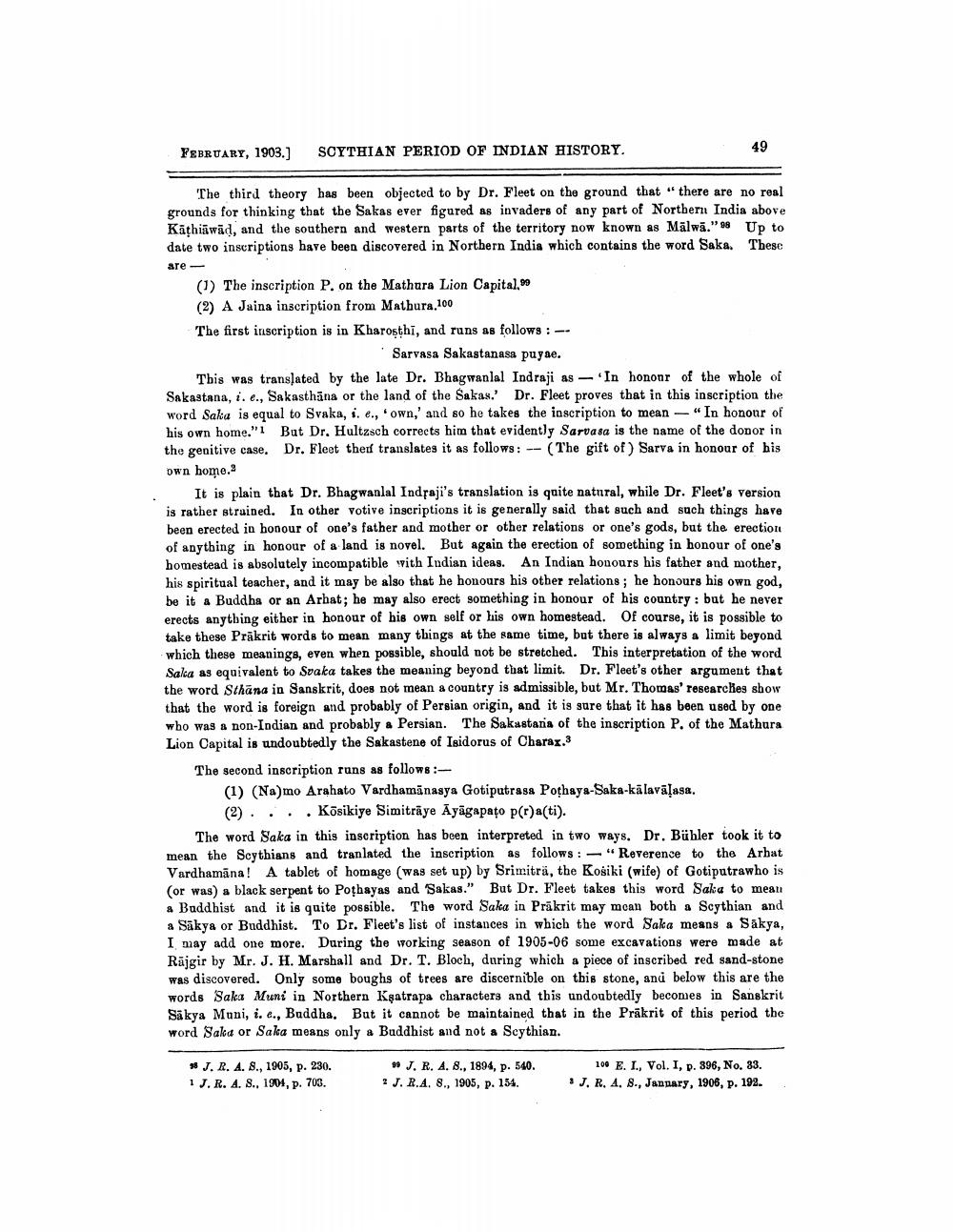________________
FEBRUARY, 1903.)
SCYTHIAN PERIOD OF INDIAN HISTORY
49
The third theory has been objected to by Dr. Fleet on the ground that there are no real grounds for thinking that the Sakas ever figured as invaders of any part of Northern India above Kāțhiāwād, and the southern and western parts of the territory now known as Mälwä."$ Up to date two inscriptions have been discovered in Northern India which contains the word Saka. These are —
(1) The inscription P. on the Mathura Lion Capital, 99 (2) A Jaina inscription from Mathura 100 The first inscription is in Kharosthi, and runs as follows : -.
Sarvasa Sakastanasa puyae. This was translated by the late Dr. Bhagwanlal Indraji as - 'In honour of the whole of Sakastana, i. e., Sakasthāna or the land of the Sakas.' Dr. Fleet proves that in this inscription the word Saka is equal to Svaka, i. e., own,' and so he takes the inscription to mean - "In honour of his own home."1 Bat Dr. Hultzsch corrects him that evidently Sarvasa is the name of the donor in the genitive case. Dr. Fleet the translates it as follows: -- (The gift of Sarva in honour of his own home.
It is plain that Dr. Bhagwanlal Indsaji's translation is quite natural, while Dr. Fleet's version is rather strained. In other votive inscriptions it is generally said that such and such things have been erected in honour of one's father and mother or other relations or one's gods, but the erection of anything in honour of a land is novel. But again the erection of something in honour of one's homestead is absolutely incompatible with Indian ideas. An Indian honours his father and mother, his spiritual teacher, and it may be also that he honours his other relations; he honours his own god, be it a Buddha or an Arhat; he may also erect something in honour of his country: but he never erects anything either in honour of his own self or his own homestead. Of course, it is possible to take these Präkrit words to mean many things at the same time, but there is always a limit beyond which these meanings, even when possible, should not be stretched. This interpretation of the word Sala as equivalent to Svaka takes the meaning beyond that limit. Dr. Fleet's other argument that the word Sthāna in Sanskrit, does not mean a country is admissible, but Mr. Thomas' researches show that the word is foreign and probably of Persian origin, and it is sure that it has been used by one who was a non-Indian and probably a Persian. The Sakastania of the inscription P. of the Mathura Lion Capital is undoubtedly the Sakastene of Isidorus of Charax.3 The second inscription runs as follows:
(1) (Na)mo Arahato Vardhamānasya Gotiputrasa Pohaya-Saka-kā lavālasa,
(2).... Kösikiye Simitrāye Āyagapato p(t)a(ti). The word Saka in this inscription has been interpreted in two ways. Dr. Bühler took it to mean the Scythians and tranlated the inscription as follows : -" Reverence to the Arbat Vardhamāna! A tablet of homage (was set up) by Srimitra, the Kosiki (wife) of Gotiputrawho is (or was) a black serpent to Pothayas and Sakas." But Dr. Fleet takes this word Saka to mean a Buddhist and it is quite possible. The word Saka in Prākrit may mcan both a Scythian and a Säkya or Buddhist. To Dr. Fleet's list of instances in which the word Saka means a Sakya, I may add one more. During the working season of 1905-06 some excavations were made at Rājgir by Mr. J. H. Marshall and Dr. T. Bloch, during which a piece of inscribed red sand-stone was discovered. Only some boughs of trees are discernible on this stone, and below this are the words Saka Muni in Northern Kşatrapa characters and this undoubtedly becomes in Sanskrit Säkya Muni, i. e., Buddha. But it cannot be maintained that in the Prākrit of this period the word Saka or Saka means only a Buddhist and not a Scythian.
* J. R. A. 8., 1905, p. 230. 1 J. R. A. 8., 1904, p. 703.
* J. R. A. 8., 1894, p. 540. ? J. R.A. 8., 1905, p. 154.
100 E.I., Vol. I, p. 396, No. 33. J. R. 4. 8., Jangary, 1906, p. 192.




